I think there is plenty more to discuss about the advantages, applications, and limitations of this design. We are greatly indebted to those willing to investigate this and publish their test data and comments about it. So far we have not really seen a detailed investigation into the results of varying thickness or density of the construction materials, or of the differences between, for example, the performance of traditional woofers and BMR and other transducers in this geometry. I have some experiences in this regard, but I would like to see things like this done by others than myself, to detach my own ego from the process. This is about research, not about personalities, which is why I will not be drawn into making it a debate about competence or qualifications.
I cannot overstate my own gratitude for being allowed to present my own observations and experiences in such a forum, where professionals and interested parties from all over the world can finally hear about this. Viewers can finally receive enough information to enable them to investigate this for themselves and draw their own conclusions. This is how science is done, and if there is a place in the world for the hypercube loudspeaker it will be made by people brave enough to step outside their comfort zones and try something new.
I cannot overstate my own gratitude for being allowed to present my own observations and experiences in such a forum, where professionals and interested parties from all over the world can finally hear about this. Viewers can finally receive enough information to enable them to investigate this for themselves and draw their own conclusions. This is how science is done, and if there is a place in the world for the hypercube loudspeaker it will be made by people brave enough to step outside their comfort zones and try something new.
Starting to feel better, got a little more time looking at the model for this thing.
So a little more on designing, in case you don't want to use Tesserax's calculator. I had been thinking that the volume should scale with the cube of the linear scaling, but I wanted to double check before saying anything. I was right. So if you scale the linear dimensions of the enclosure by X, then the volume is scaled by X^3. So all you need is the base numbers and you can scale the whole thing. For the drawings in post #150, the square panel length is 1, which gives a box volume of 1.833 (units are whatever you're using, cubed). Now this is the volume of the whole box, not just the inside. So you need to scale the volume to about what the inside should be. We need to calculate what the inside edge would be given for any panel thickness and then scale the volume to that number (effectively calculating the volume of a box that fits into your box). I'm not going to show my work here since that would be even more long winded than this already is.
So in conclusion: with the drawings from #150, you can scale the dimensions with a scaling factor X to build a box with a length on the square face of X. The resulting volume will be approximately (X-1.414*T)^3*1.833 minus driver and other parts volume, where T is the panel thickness. A couple of assumptions are made with this equation, but I estimate error to be less than 1% (checking against CAD). Tesserax, can you confirm using your calculator?
So a little more on designing, in case you don't want to use Tesserax's calculator. I had been thinking that the volume should scale with the cube of the linear scaling, but I wanted to double check before saying anything. I was right. So if you scale the linear dimensions of the enclosure by X, then the volume is scaled by X^3. So all you need is the base numbers and you can scale the whole thing. For the drawings in post #150, the square panel length is 1, which gives a box volume of 1.833 (units are whatever you're using, cubed). Now this is the volume of the whole box, not just the inside. So you need to scale the volume to about what the inside should be. We need to calculate what the inside edge would be given for any panel thickness and then scale the volume to that number (effectively calculating the volume of a box that fits into your box). I'm not going to show my work here since that would be even more long winded than this already is.
So in conclusion: with the drawings from #150, you can scale the dimensions with a scaling factor X to build a box with a length on the square face of X. The resulting volume will be approximately (X-1.414*T)^3*1.833 minus driver and other parts volume, where T is the panel thickness. A couple of assumptions are made with this equation, but I estimate error to be less than 1% (checking against CAD). Tesserax, can you confirm using your calculator?
Muddjester, you are right on the money. That is exactly my thinking: subtracting the horizontal width of the 45 degree bevel which from simple trig is .7071 times the thickness on both ends of the square side length so 1.414 times the thickness. Here is the relevant section of code from my ASP page at calculatefromsquare.asp (Calc from square) :
<%
'time to do some calculations
innersquare = outersquare - 1.414*(thickness)
innervolume = (11/6) * innersquare^3 'cm3
innersquare = innersquare * 100 'in cm
%>
This is of course only a first order approximation. Since the square bevel is wider than the (unbeveled) thickness at the long ends of the triangles, the baffle plate protrudes very slightly into the interior, as your excellent CAD drawing shows. If everything except the square were a little thicker, the fit would be perfect and the inner volume exact...but I agree that the error involved with uniform thickness is on the order of less than 1%.
<%
'time to do some calculations
innersquare = outersquare - 1.414*(thickness)
innervolume = (11/6) * innersquare^3 'cm3
innersquare = innersquare * 100 'in cm
%>
This is of course only a first order approximation. Since the square bevel is wider than the (unbeveled) thickness at the long ends of the triangles, the baffle plate protrudes very slightly into the interior, as your excellent CAD drawing shows. If everything except the square were a little thicker, the fit would be perfect and the inner volume exact...but I agree that the error involved with uniform thickness is on the order of less than 1%.
Additional note: that last line
"innersquare = innersquare * 100 'in cm"
was a holdover from an earlier version where I was inputting the outer square in meters, not cm. it doesn't belong in this version but fortunately the innersquare size is not one of the outputs of calculatefromsquare -- just the innervolume and the external cutting sizes for the pieces.
"innersquare = innersquare * 100 'in cm"
was a holdover from an earlier version where I was inputting the outer square in meters, not cm. it doesn't belong in this version but fortunately the innersquare size is not one of the outputs of calculatefromsquare -- just the innervolume and the external cutting sizes for the pieces.
Calcfromvolume.asp (Calc from volume) does the reverse. it starts with the Vas, the innervolume you input and then derives the inner square side from s = cube root of (6/11)Vas, taking the cube root by raising it to the 1/3 power.
<%
'time to do some calculations
innersquare = (6*vas/11)^.333333 ' in meters
innersquare = innersquare * 100 'in cm
outersquare = innersquare + 1.414 * thickness
outersquareinches = outersquare / 2.54
rhombus = outersquare * .866
rhombusinches = rhombus / 2.54
%>
Access to both calcfromsquare.asp and calcfromvolume.asp is given by calculate.html
you can find it at this link: Calculate.html
The pages are not pretty yet, merely functional. I tried to make the them small enough but with large enough font to use even from a smart phone.
<%
'time to do some calculations
innersquare = (6*vas/11)^.333333 ' in meters
innersquare = innersquare * 100 'in cm
outersquare = innersquare + 1.414 * thickness
outersquareinches = outersquare / 2.54
rhombus = outersquare * .866
rhombusinches = rhombus / 2.54
%>
Access to both calcfromsquare.asp and calcfromvolume.asp is given by calculate.html
you can find it at this link: Calculate.html
The pages are not pretty yet, merely functional. I tried to make the them small enough but with large enough font to use even from a smart phone.
Hypercube (mass-damped) with PRV 5MR450NDY
My next experiment was to see how smooth I can make the Hypercube for my favorite driver, the PRV 5MR450NDY (more info on this driver here http://www.diyaudio.com/forums/full-range/259293-prv-5mr450-ndy-fast-applications.html) to use as a monitor. I made the panels with a 6.00 in edge for the square and 5.20 in edge for the rhomboids. For each plate, I used a smaller plate from the 5.62in x 4.00in Hypercube and I put several dabs of plembers' putty in between the foam core panels, the edges then got several tack points of hot melt glue to secure the plates together. The putty adds mass and the second plate sandwich construction helps to stiffen and dampen the natural resonances. Tapping the panels, you can hear a dull sound rather than the lively resonance. A Hypercube with 6.00 in square edge has a volume of 6.5 liters, accounting for material thickness, probably closer to 6.35 liters.
Here is the panel getting dabs of putty:
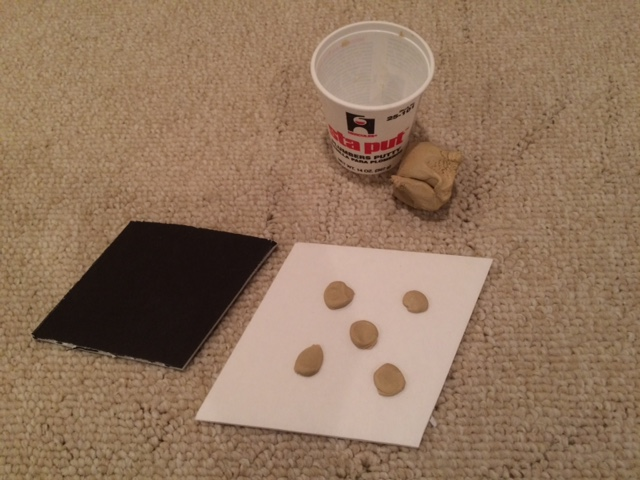
Here are all the mass-loaded panels together, note added triple ply cardboard and bracing for driver mounting, I used a double layer of foam core for the baffle plus the cardboard - this is a heavy driver capable of high SPL (250 watts RMS):
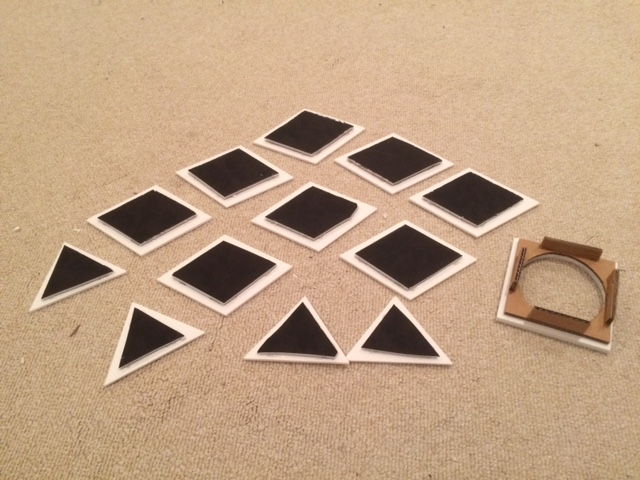
Gluing panels together:
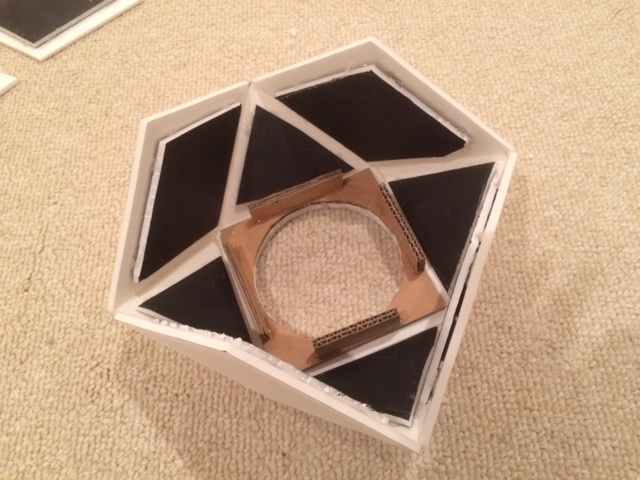
Finished mass-damped Hypercube with 5MR450NDY driver mounted:
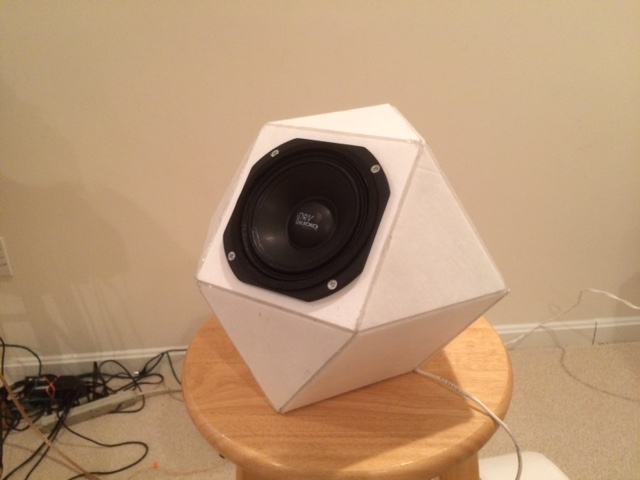
Here is measured response at 0.5m showing very low HD, however, a couple of sharp peaks of 2nd harmonic distortion at -40dB are present at 350Hz and 1.1kHz, overall though, a very clean sounding speaker with most HD around -55dB above 200Hz:
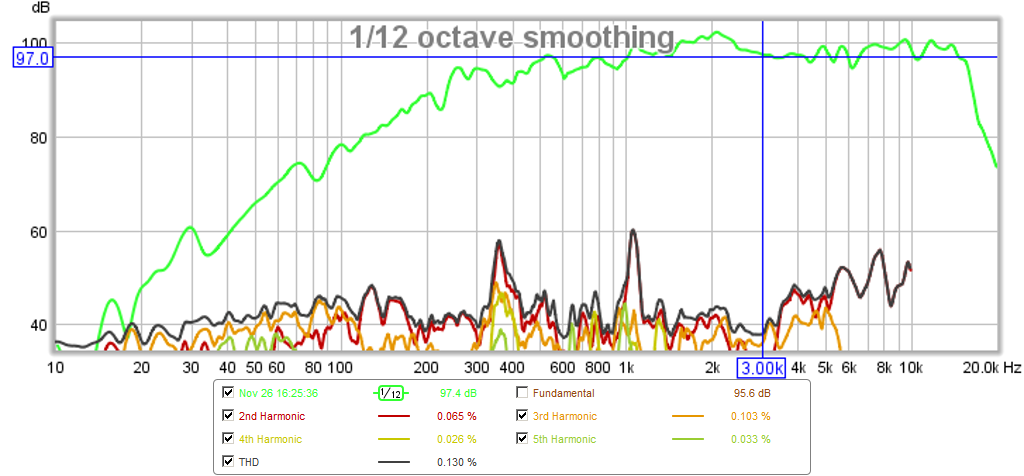
For comparison of the HD of the TC9GD, notice how much more there is below 300Hz (most of it is the driver, but some is the enclosure vibration):
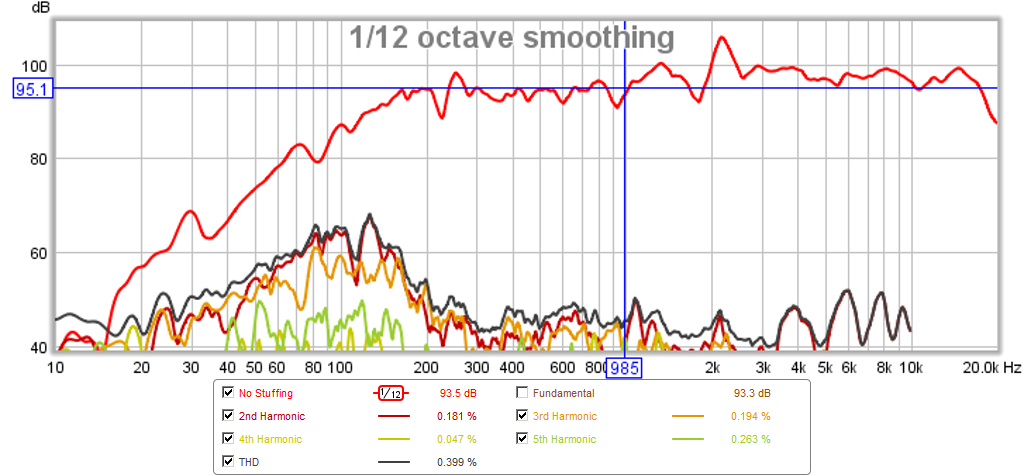
Here is the phase:
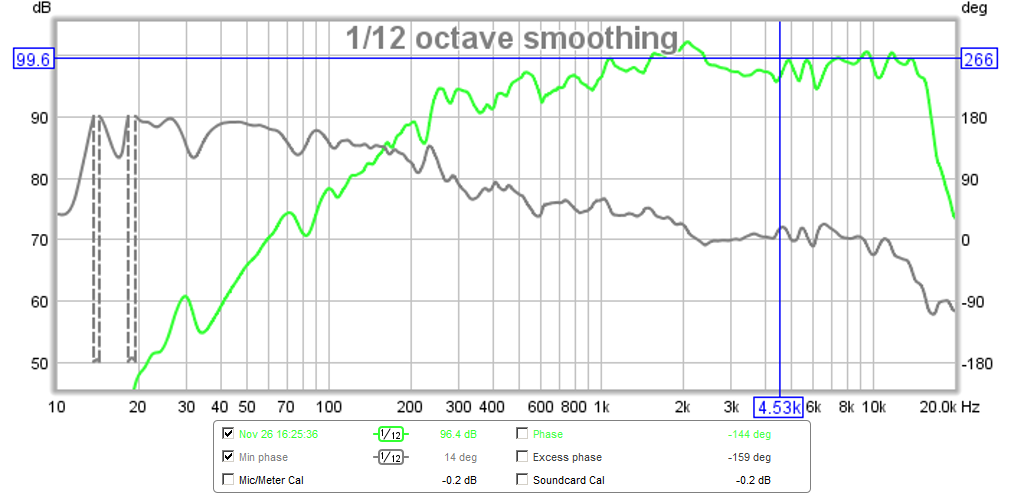
Here is the Impulse response - slight ringing from cone breakup (this was apparent on other speakers with this driver):
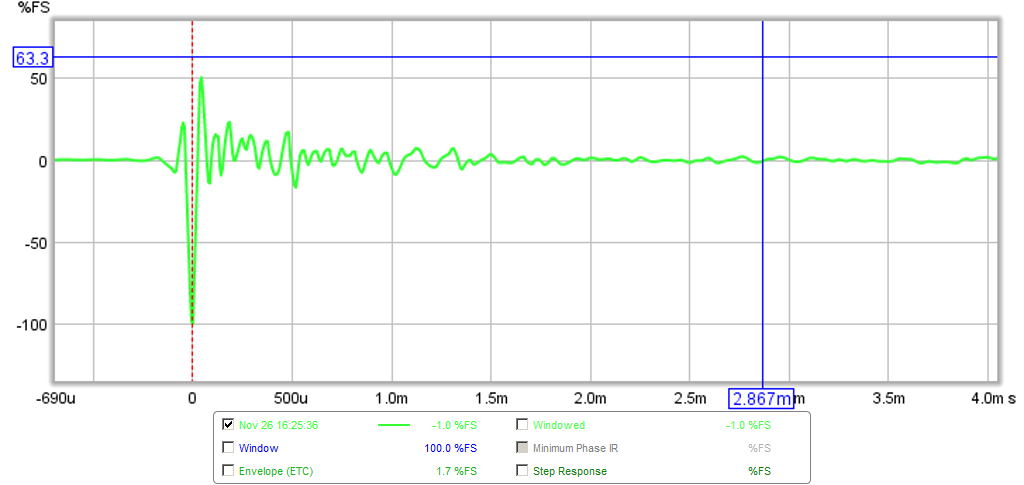
Here is the response compared to the Vifa TC9FD in the smaller Hypercube, both driven at 2.83v and measured at 1m distance:
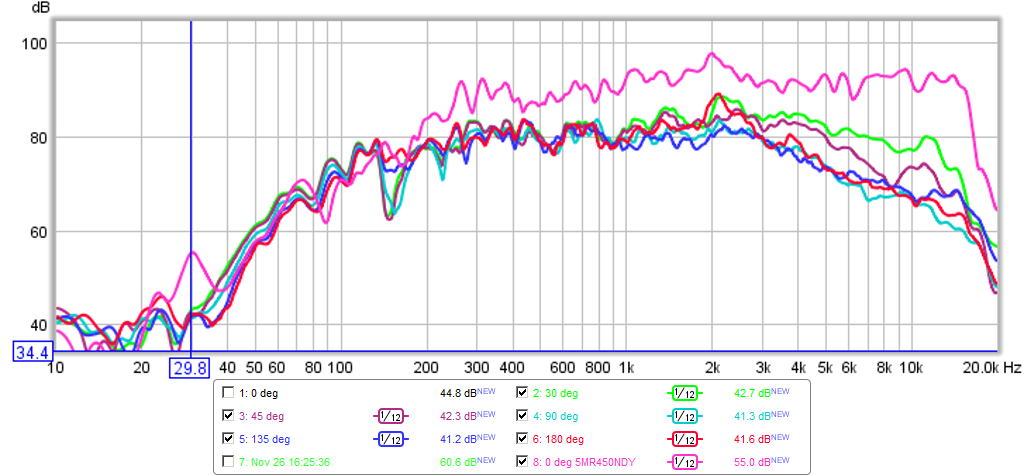
So how does it sound? I only had a chance to listen to a couple of tracks - vocals with Anne Bisson and Diana Krall. They sound wonderful! The 5MR450NDY is already one of my favorite drivers, and mounted in this enclosure, there is a very clear transparency to the sound. Note that I am not using ANY stuffing at all so the sound is much more open than a heavily stuffed box. I like the sound a lot.
Another easy and quick speaker to make - 2 hrs and 3/4 sheet of foam. 5 glue sticks though and half a tub of putty.
My next experiment was to see how smooth I can make the Hypercube for my favorite driver, the PRV 5MR450NDY (more info on this driver here http://www.diyaudio.com/forums/full-range/259293-prv-5mr450-ndy-fast-applications.html) to use as a monitor. I made the panels with a 6.00 in edge for the square and 5.20 in edge for the rhomboids. For each plate, I used a smaller plate from the 5.62in x 4.00in Hypercube and I put several dabs of plembers' putty in between the foam core panels, the edges then got several tack points of hot melt glue to secure the plates together. The putty adds mass and the second plate sandwich construction helps to stiffen and dampen the natural resonances. Tapping the panels, you can hear a dull sound rather than the lively resonance. A Hypercube with 6.00 in square edge has a volume of 6.5 liters, accounting for material thickness, probably closer to 6.35 liters.
Here is the panel getting dabs of putty:

Here are all the mass-loaded panels together, note added triple ply cardboard and bracing for driver mounting, I used a double layer of foam core for the baffle plus the cardboard - this is a heavy driver capable of high SPL (250 watts RMS):

Gluing panels together:

Finished mass-damped Hypercube with 5MR450NDY driver mounted:

Here is measured response at 0.5m showing very low HD, however, a couple of sharp peaks of 2nd harmonic distortion at -40dB are present at 350Hz and 1.1kHz, overall though, a very clean sounding speaker with most HD around -55dB above 200Hz:

For comparison of the HD of the TC9GD, notice how much more there is below 300Hz (most of it is the driver, but some is the enclosure vibration):

Here is the phase:

Here is the Impulse response - slight ringing from cone breakup (this was apparent on other speakers with this driver):

Here is the response compared to the Vifa TC9FD in the smaller Hypercube, both driven at 2.83v and measured at 1m distance:

So how does it sound? I only had a chance to listen to a couple of tracks - vocals with Anne Bisson and Diana Krall. They sound wonderful! The 5MR450NDY is already one of my favorite drivers, and mounted in this enclosure, there is a very clear transparency to the sound. Note that I am not using ANY stuffing at all so the sound is much more open than a heavily stuffed box. I like the sound a lot.
Another easy and quick speaker to make - 2 hrs and 3/4 sheet of foam. 5 glue sticks though and half a tub of putty.
Attachments
-
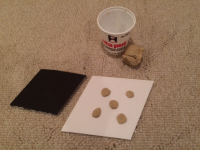 Hypercube-5MR450NDY-build-01.png496.8 KB · Views: 2,100
Hypercube-5MR450NDY-build-01.png496.8 KB · Views: 2,100 -
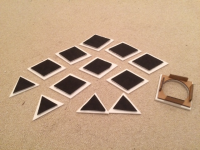 Hypercube-5MR450NDY-build-02.png445.8 KB · Views: 2,069
Hypercube-5MR450NDY-build-02.png445.8 KB · Views: 2,069 -
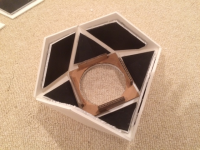 Hypercube-5MR450NDY-build-03.png424.2 KB · Views: 2,059
Hypercube-5MR450NDY-build-03.png424.2 KB · Views: 2,059 -
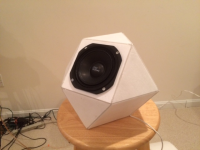 Hypercube-5MR450NDY-build-05.png297.3 KB · Views: 3,926
Hypercube-5MR450NDY-build-05.png297.3 KB · Views: 3,926 -
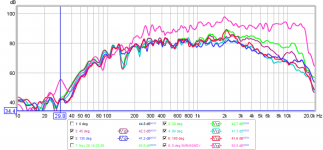 Hypercube-5MR450NDY-Compare-TC9FD.png146.1 KB · Views: 1,989
Hypercube-5MR450NDY-Compare-TC9FD.png146.1 KB · Views: 1,989 -
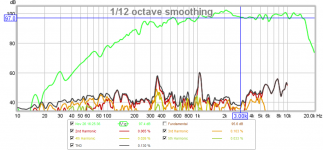 Hypercube-5MR450NDY-HD.png138.9 KB · Views: 1,817
Hypercube-5MR450NDY-HD.png138.9 KB · Views: 1,817 -
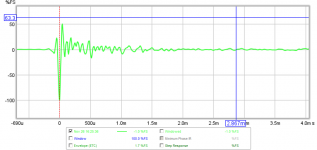 Hypercube-5MR450NDY-Impulse.png58.9 KB · Views: 1,969
Hypercube-5MR450NDY-Impulse.png58.9 KB · Views: 1,969 -
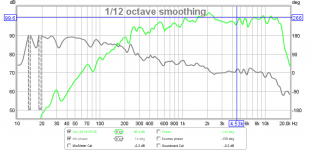 Hypercube-5MR450NDY-Phase.png104.6 KB · Views: 1,992
Hypercube-5MR450NDY-Phase.png104.6 KB · Views: 1,992
Last edited:
However, I'm still not so sure so much sound radiating from the enclosure would be a good thing (I kinda feel like that's what we're trying to show here, maybe it's just what I care about the most. I still want to build these, I just want to know the limitations to properly design it). xrk971 is right that the sound from directly in front of the speaker is very low in distortion (thank you for pointing that out) and has a great transient response (which I'm convinced is a great property to have in a speaker), but the sound coming from directly behind is full of distortion (I'm pretty sure this is a property of sound radiated from an enclosure panel) and I'm still not convinced that the sound measured from the sides isn't just a property of the small enclosure baffle and speaker beaming. I think that if these speaker enclosures radiated a lot, that is a lot more than we've already seen, it would not sound great in the long term due to increased distortion. I have not seen evidence to the contrary here. If anyone else has, please point me to it.
To get back to my point about diffraction and/or driver beaming, it occurred to me to look at the driver datasheet and compare it to xrk971's off axis measurements in post #190. At 30° (the only angle common to both), it looks to me like the roll off of the high end starts at about the same place, and the roll off is about twice the rate in xrk971's measurements. If the manufacture's measurements were taken on an "infinite" baffle, it would be operating in half space, while xrk971's measurements were most likely in full space. Full vs. half space would explain the rate difference. Therefor, I see no deviation from standard theory and no indication that the enclosure is adding to the radiated sound, except where there is a resonance in the back four panels which shows up as a peak in the 0° response.
I hope this doesn't come across as overly kurt, I have a hard time telling tone in my own text. My intent is to state what I can see in the data and why and discuss it with others.
Hi Muddjester,
I'm glad you're feeling better these days. In my experience, the type of distortion that leads to fatigue in the long run is harmonic (non-linear) distortion (particularly high-order and odd order). In that regard I believe there is nothing to worry about with this design. The low-level wide-band panel radiation is not enough to add to the spl in the far-field and just provides a beautiful ambient characteristic. Besides, if desired, this effect can be reduced with the use of stuffing or stiffer panels (I prefer no stuffing). I have not yet done a 180 degree polar plot with the equivalent volume sealed box, but I'm pretty sure the the results would not be pretty (I could do this at some point if you'd like). In my opinion, the peak in the zero degree response (which again, could be greatly reduced with stuffing or, as you know, partially reduced with filtering) is a very small price to pay for the apparent benefits of this enclosure shape.
xrk971:
Outstanding job once again. Like me, you have noticed a significant reduction of HD in the lower frequency range. I can't wait until you try a driver with more bass capability or perhaps a "hypercube sub".
Outstanding job once again. Like me, you have noticed a significant reduction of HD in the lower frequency range. I can't wait until you try a driver with more bass capability or perhaps a "hypercube sub".
Hi,
There is nothing to suggest that this design has anything
to do with or any avantage in any respects related to the
distortion profile of the drivers, other than of course its
peak will be the 2nd, 3rd etc of lower frequencies.
There simply isn't low level wideband output, its complete
and utter nonsense, a figment of attempted understanding.
No understanding = no way forward. Seems to me that
is very similar to claiming something is the pinnacle.
rgds, sreten/
There is nothing to suggest that this design has anything
to do with or any avantage in any respects related to the
distortion profile of the drivers, other than of course its
peak will be the 2nd, 3rd etc of lower frequencies.
There simply isn't low level wideband output, its complete
and utter nonsense, a figment of attempted understanding.
No understanding = no way forward. Seems to me that
is very similar to claiming something is the pinnacle.
rgds, sreten/
xrk971:
Outstanding job once again. Like me, you have noticed a significant reduction of HD in the lower frequency range. I can't wait until you try a driver with more bass capability or perhaps a "hypercube sub".
Most of the reduced HD is the driver itself - as it has a high fs of 175Hz and a stiff suspension so there is not much movement down below 200Hz. This enclosure is much like a sealed cabinet - no bass really so must be used with a sub as in a FAST to get the full range down low. On your RS100's I am surprised you are able to get that much bass from them - probably quite a bit of HD below 150Hz though.
xrk971:
Outstanding job once again. Like me, you have noticed a significant reduction of HD in the lower frequency range. I can't wait until you try a driver with more bass capability or perhaps a "hypercube sub".
Great alive again/voicecoil repaired 😛....
You right gmad the Vifa driver in this box volume has less low extension, but funny the two drivers TC9FD verse RS100-4 in sim sealed box presented to same box Qtc taken nearly exactly same high pass plot but Vifa needs far more volume at same box Qtc and Dayton has far more Xmax and for bass notes.
Last edited:
Glad it's open again. Here are sound clips of the Hypercube with Vifa TC9FD's and a sub XO at 200Hz.
http://www.diyaudio.com/forums/full-range/223313-foam-core-board-speaker-enclosures-252.html#post4135528
http://www.diyaudio.com/forums/full-range/223313-foam-core-board-speaker-enclosures-252.html#post4135528
xrk971 feedback sound clips is great here even the chains they've been thru.
Hypercube no XO filter only LP at sub cool.
A certain sound signature in these two clips suits my PC desktop setup to be very live like and remind me of a track member kees52 linked at your trynergy thread which had same influence my PC desktop, link is here to YouTube https://www.youtube.com/watch?v=mAYXzegWnn4&feature=youtu.be&list=UUFM73rUhzLW_bQ8ytUtyt_Q.
Hypercube no XO filter only LP at sub cool.
A certain sound signature in these two clips suits my PC desktop setup to be very live like and remind me of a track member kees52 linked at your trynergy thread which had same influence my PC desktop, link is here to YouTube https://www.youtube.com/watch?v=mAYXzegWnn4&feature=youtu.be&list=UUFM73rUhzLW_bQ8ytUtyt_Q.
I think a small hypercube for mid+ freqs and a larger hypercube sub would be audioporn to the ears.
Most of the reduced HD is the driver itself - as it has a high fs of 175Hz and a stiff suspension so there is not much movement down below 200Hz. This enclosure is much like a sealed cabinet - no bass really so must be used with a sub as in a FAST to get the full range down low. On your RS100's I am surprised you are able to get that much bass from them - probably quite a bit of HD below 150Hz though.
Oops, I should have realized I was looking at the response of two different drivers. Since I noticed less HD with my RS100 in the lower octaves with the hypercube enclosure I thought for a minute that that's what I was seeing in your post.
Thanks for the feedback Byrtt. I like the song that Kees has on his video too - in fact, I bought it after hearing it back then. It is Patricia Barber's Taste of Honey form the Cafe Blue album. Great song.
Great alive again/voicecoil repaired 😛....
You right gmad the Vifa driver in this box volume has less low extension, but funny the two drivers TC9FD verse RS100-4 in sim sealed box presented to same box Qtc taken nearly exactly same high pass plot but Vifa needs far more volume at same box Qtc and Dayton has far more Xmax and for bass notes.
Yes, it's good to be back! The Dayton has decent Xmax for it's size, however, I never expected to get bass from it like I'm hearing now. I think that the profound increase in bass quality (not to mention the slight increase in output) might be the hallmark of the hypercube enclosure.
Also interesting is the observation by Tesserax that he has yet to observe a hypercube enclosure showing the effect of too little volume for a given driver.
Also interesting is the observation by Tesserax that he has yet to observe a hypercube enclosure showing the effect of too little volume for a given driver.
I am listening to my 0.4x Karlsonator and it sounds fantastic with rich full bass by virtue of its design as a mass loaded tapered quarter wave transmission line (ML-TQWT) design. I think it sounds better than the Hypercube (huge sound from very small box, lots of bass and great dispersion) and it very easy to build. You should give it a try. I tried the Hypercube so in fairness, you should give the mini Karlsonator a try. Look at how popular the thread is and how many happy builds there have been.
http://www.diyaudio.com/forums/full-range/239338-mini-karlsonator-0-53x-dual-tc9fds.html
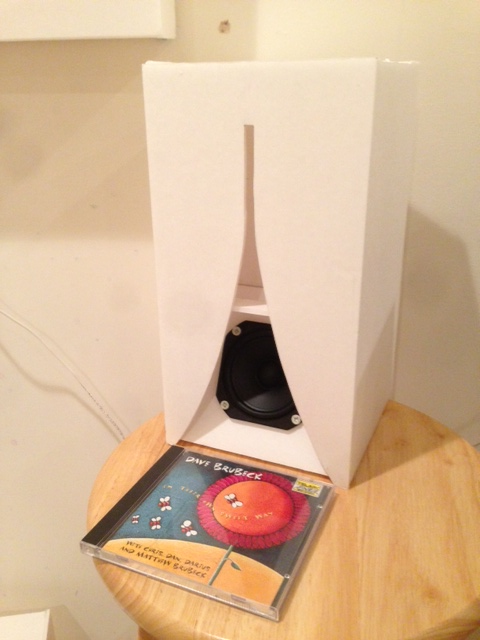
- Status
- Not open for further replies.
- Home
- Loudspeakers
- Full Range
- Hypercube Loudspeakers
 thread reopened. keep discussions on a high level pretty please.....
thread reopened. keep discussions on a high level pretty please.....